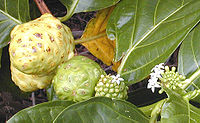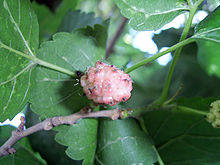- Multiple fruit
-
Multiple fruits are fruits that are formed from a cluster of flowers (called an inflorescence). Each flower in the inflorescence produces a fruit, but these mature into a single mass.[1] Examples are the pineapple, fig, mulberry, osage-orange, and breadfruit.
 In some plants, such as this noni, flowers are produced regularly along the stem and it is possible to see together examples of flowering, fruit development, and fruit ripening
In some plants, such as this noni, flowers are produced regularly along the stem and it is possible to see together examples of flowering, fruit development, and fruit ripening
In the photograph on the left, stages of flowering and fruit development in the noni or Indian mulberry (Morinda citrifolia) can be observed on a single branch. First an inflorescence of white flowers called a head is produced. After fertilization, each flower develops into a drupe, and as the drupes expand, they become connate (merge) into a multiple fleshy fruit called a syncarp. There are also many dry multiple fruits.
Other examples of multiple fruits:
- Platanus, teasel, Asteraceae multiple achenes from multiple flowers, in a single fruit structure
- Mulberry, multiple flowers form one fruit
- Common Fig, multiple flowers form one fruit (inside the fruit)
Similar structures are formed from single flowers that have more than one pistil, and these are called aggregate fruits, e.g.:
- Strawberry, aggregate of achenes on a fleshy receptacle
- Tuliptree, aggregate of samaras.
- Sweet gum, aggregate of capsules.
- Magnolia, aggregate of follicles.
See also
- Fruits
- Compound fruit
References
Types of fruits Types of fruits Categories of fruits Function Categories:
Wikimedia Foundation. 2010.

